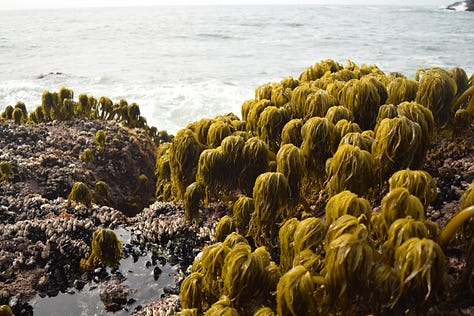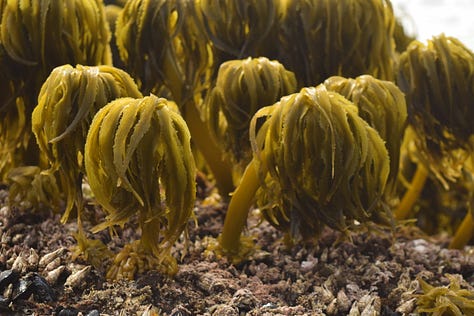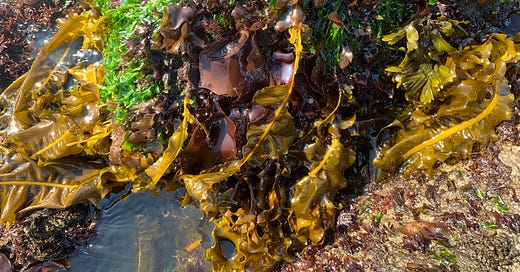Seaweed Foraging in Oregon
The Pacific Northwest is home to more kelp diversity than anywhere else on earth, yet most overlook it as an incredible importance natural resource!
It’s finally seaweed foraging season in Oregon! I figured it was time to share a little about best practices and seaweed harvesting regulations on our coastline. Most people may not even realize that there even is a seaweed foraging season along the Oregon Coast, but there is! Harvesting of live seaweeds is actually not something you can do year round.
Here’s a little nit and gritty on seaweed harvesting in Oregon, before I get into my personal practices.
The season of live seaweed (meaning seaweed still attached to a substrate) harvesting runs from March 1st to June 15th, and is regulated by the Parks and Recreation Department rather than Oregon Department of Fish and Wildlife (who regulate all shellfish and fishing). There is no license required to harvest seaweeds along the coast, but there is a limit set at one-gallon volume container per day and up to three gallons per calendar year.
When harvesting live seaweeds, in Oregon or anywhere, there are a number of things to keep in mind.
As part of the regulations, people are only allowed to harvest by hand, using a knife or similar instrument. Tearing or using instruments like rakes or forks is prohibited. The disturbance or removal of holdfasts (or the root-like structure that attaches seaweeds to their substrate) is not allowed. To stay within sustainable harvest practices and within legal regulations, harvesters should always cut seaweeds a few inches (or feet in the case of some kelps) above the holdfast. The holdfast allows for regrowth of the algae, so leaving it in tact is crucial for the persistence of seaweed.
There are species that are completely off limits. Sea Palm (Postelsia sp.), eel grass (Zostera spp.) and surf grass (Phyllospadix spp.) may not be cut or disturbed in any area. As well as any species on the “Rare, Threatened and Endangered Species of Oregon” list. Eelgrass and surf grass are two species protected as essential fish habitat, while sea palm is a species that has previously been harvested to extremely low populations.



There are also some areas that are completely off limits. There is no disturbance or removal of living or non-living plants in marine reserves, marine protected areas, marine gardens, intertidal research reserves, and wildlife or habitat refuges. In snowy plover management areas, there is no salvaging or removal of marine plants during seasonal closures (between March 15 and September 15th). Definitely do your research before you get to a specific location!
Please refer to Oregon’s General Ocean Shore State Recreation Area Rules for more information!
Best practices of foraging seaweed are similar to all other foraged goods, please do not ever clear an area of a particular seaweed. If there’s only a little bit present, please leave it to allow it to continue growing throughout the year. If you go to an area in March and the growth appears very limited, rather than harvesting a tiny bit from every individual you see, leave it and come back in a few months when you can harvest more while potentially disturbing less.
Identification of seaweeds and kelps can be a little tricky to start, just like mushrooms. The good news is that, unlike mushrooms, almost all seaweeds are edible, and as far as I know (don’t take my word for it) none are going to kill you. Edible does not mean palatable though, and while you could theoretically eat most to all of seaweeds on our coast, some are super metallic, or plastic-y, or slimy, and may not be something you WANT to eat. There’s a handful of sought after edible species on our coast, and once you start seeing them they become pretty easy to identify. I won’t get into identification here but save it for another post (or maybe a guide book)!
With the limits in seasons and volume of seaweed allowed, there’s a number of personal practices I have to get the most out of a sustainable harvest, and preserve my harvest for year-round use. Keep reading for ways to get seaweed out of harvest season as well as a quick and easy guide to processing seaweeds and kelps!
Keep reading with a 7-day free trial
Subscribe to Shifting Tides to keep reading this post and get 7 days of free access to the full post archives.





